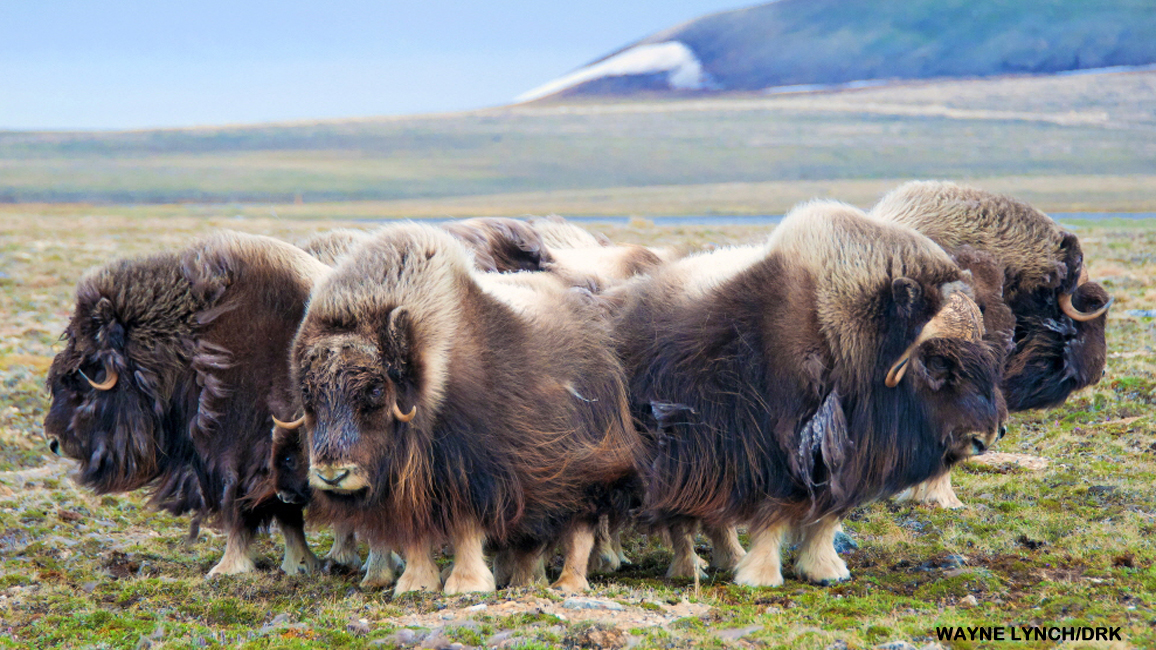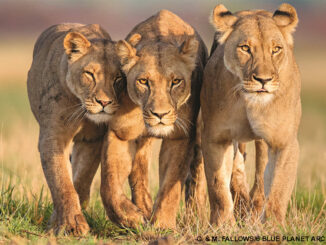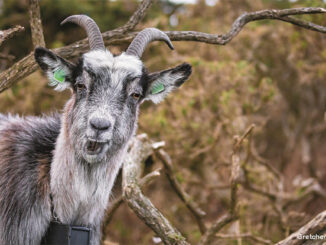
Teamwork
By Ellen LambethThese animals don’t go it alone! They find a friend or two—or even more. By working together, they can accomplish almost anything.

BUILD A WALL
A single muskox—with its huge, horned head and monster shoulders—looks threatening enough. But use more heads and shoulders to build a shaggy fortress like this one, and NO one is getting in! Muskoxen often circle around their calves this way to protect them from hungry wolves.
ROUND ’EM UP
American white pelicans cooperate at mealtime. First, they line up behind a bunch of fish and start paddling toward shore (1). That herds the fish into shallow water so they can’t escape. Then the birds just dunk (2), scoop, and gulp!

FOLLOW SCHOOL RULES
Many kinds of fish, including these scad, swim together in big groups called schools. One reason they may do it is to create confusion for hungry predators. It’s just too hard to focus on any one fish in a big, tightly packed ball like this one.
GANG UP
African wild dogs use group tactics to capture prey. First, one dog leads the pack in a chase. When the prey is too tired to run anymore, the pack members circle around and close in for the kill. This Cape buffalo mom is doing her best to protect her calf.
HUDDLE FOR WARMTH
Emperor penguins come ashore to raise families during the coldest time of year at the coldest place on Earth: winter in Antarctica! During a blizzard, the penguins huddle together for warmth. They constantly switch positions so that no penguin has to stay too long at the coldest outer edges.
CHASE ’EM IN
A bunch of Galápagos sea lions have just teamed up to herd a group of fish ashore. Once on dry land, the fish can’t escape. Meanwhile, a few pelicans fly in to take advantage of the seals’ teamwork.

NET ’EM
People use nets to catch many fish at once. Humpback whales do, too. Here’s how: They swim below a school of fish and then spiral upward while releasing streams of bubbles from their blowholes. The bubbles form a “net” that forces the fish closer and closer together toward the water’s surface. Then the whales swim up through the middle of their bubble net and open wide.
VIDEO: WATCH HUMPBACK WHALES IN ACTION!
MOB ’EM
Big birds (such as this harrier in the bottom right corner) often prey on smaller birds (such as these avocets). One-on-one, the smaller birds don’t stand much of a chance. But when a whole group of them spot the predator first, they may gang up on it. Then they squawk and peck at it till they chase it away.
FLY IN FORMATION
Everybody knows that flocks of geese such as these greylags often migrate in V-formations. But why? Because it saves energy! The bird in front works the hardest. And each other bird gets a bit of lift from the one in front of it. As they tire, they switch positions.
TEAMWORK HALL OF FAME
As you’ve seen, many different kinds of animals accomplish a lot by working together. But there’s one kind of animal that takes teamwork to the extreme: ANTS!
“WEAVE HO!”
Weaver ants make their treetop nests by “sewing” leaves. First, many legs, bodies, and jaws pull and hold on to the leaf edges. Then the ants will use ant silk (like spider silk) to “stitch” the edges together.
FORM A RAFT
What happens to fire ants when their underground colony starts to flood? They get out, link up with their nest mates, and float off in a big clump called a raft. Sooner or later, the raft hits dry land or the water level goes back down.
SOW AND REAP
Leafcutter ants are famous for growing gardens. Here, they team up to gather bits of leaves, which they’ll carry to underground nests. There, as the leaves begin to rot, a special kind of fungus grows on them. The ants then harvest the fungus for their food.
Way to go, teams!
















